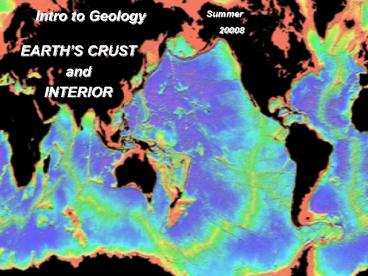Intro to Geology - PowerPoint PPT Presentation
1 / 20
Title:
Intro to Geology
Description:
Plates are named for continents and oceans: ... (arcuate) lines of. volcanoes. Some are arcs. of islands. Some are atop coastal mountains ... – PowerPoint PPT presentation
Number of Views:124
Avg rating:3.0/5.0
Title: Intro to Geology
1
Intro to Geology
Summer 20008
- EARTHS CRUST
- and
- INTERIOR
2
Day 2
- PLATE TECTONICS AND THE STRUCTURE OF THE EARTH
- Linear concentrations of volcanoes, quakes
- and mountains
- Lithospheric Plate Boundaries
- 3 Plate Boundary Types
- Earths Interior (beneath the crust)
3
Mountain ranges on land and on the ocean floor
4
Lines of active volcanoes
5
Earthquake risk zones
Also a map of the worlds young mountain chains!
6
Earthquakes - same lines as volcanoes
7
Lines of active volcanoes
8
PLATE BOUNDARIES
9
Plates are named for continents and oceans
10
Most plates include ocean and continental
lithosphere
11
PLATE TECTONICS THE RULES
- Earths surface layer (the lithosphere) is
divided into a series of rigid plates - Relative motions between plates can be
described as rotations - Deformation only occurs at plate boundaries
- If lithosphere is created in one area, it is
destroyed in another
12
Three types of plate boundary
divergent convergent
transform
MELTING reduced pressure water
added none
13
Divergent boundaries make new lithosphere
Transform boundaries
connect other boundary segments
14
Mid-ocean divergent boundary with transform
offsets
15
Divergent boundaries open oceansadding younger
crust at center
Satellite Image in Grotzinger et al. (ch. 2)
16
All Together! Note 3 Plate Boundary Types
17
Age of the ocean floor
18
Convergent boundaries consume old lithosphere
SUBDUCTION
19
Subduction generates (arcuate) lines of
volcanoes
Some are arcs of islands
e.g. Japan, Kuril Aleutian Islands
Some are atop coastal mountains
e.g. Andes, Cascades
20
Using Space for Time
- The modern oceans can be arranged in a series
- each one represents the future of the one
before, the past of the next one in series - East African Rift - not yet flooded
- Red Sea - narrow opening
- Atlantic Ocean - wider, still opening
- Pacific Ocean - widest, but closing
- Mediterranean - nearly closed
- Himalaya Mtns - closed































